Dog Returned to Shelter for Farting Too Much, is Closer to Re-Adoption
If learning to tolerate the smell of another creature’s farts isn’t love, then I don’t know what is. The Greenville County Pet Rescue in South Carolina posted a photo June 26 on it’s Facebook page of a Pitbull mix named Misty who had recently been adopted and then returned. Sadly, this is a high-kill shelter, with a dog euthanasia rate of 23.4% in 2013. What was the reason for the return of the friendly pup? Her owners said she passed too much gas.
Many of the Pet Rescue’s followers came to the dogs defense and could not fathom returning a dog because of her natural bodily functions. Many were outraged. Most suggested changing the dog’s food, but the inspiring thing that happened was that people pledged money to the rescue to prevent Misty from being euthanized.
Due to the overwhelming Internet reaction, the loveable 1 year old dog was getting closer to adoption within days. Susan Bufano, a shelter spokeswoman, told the Huffington Post, “We are still evaluating her and have a foster for her. We anticipate finding her a home.”
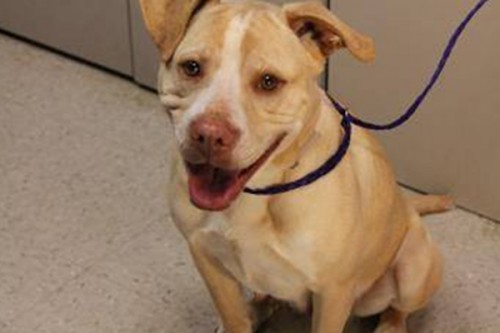
There is no question that the owners have the right to surrender the animal no matter what the reason is, but it is hard to look at this case from their point of view. Just like in cases of bad dog breath, there are also easy solutions when it comes to caring for a Flatulent Fido. Much easier and more humane, in fact, than returning the dog to a shelter in which he or she may be killed. One method is simply changing the food the dog is eating.
One Facebook user, Ginny Bowcock, summed up the sentiment of the rest of the users rather simply: “I wonder what these people do with their grandparents…put them in a farting home?”

Dog Pulling on Leash
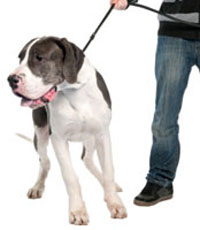
A dog pulls on the leash for several reasons:
• Sees, hears, or smells something exciting.
• Excess energy makes it hard for her to contain herself.
• Through experience, realizes that pulling on leash makes the handler walk faster or go the direction she wants.
• Because she can.
Why this dog behavior is a problem
Pulling on leash can start off innocently, but can become a problem for both the dog and the handler. The added pressure of the collar against the dog’s windpipe (trachea) can cause wheezing or coughing, which may be only temporary, or may cause long-term or even permanent damage to the dog. A dog who pulls strongly can cause the handler to lose balance and slip or fall. Strong leash pulling by a large dog, especially near roads with traffic, can lead to serious accidents.

Changing from a neck collar to either a head halter or front-attachment body harness can bring an immediate solution to leash pulling. These tools provide a mechanical advantage for the handler and do not cause pain for the dog. Using a head halter or front-attachment harness immediately allows the handler to control the direction and speed of the dog, without needing a lot of physical strength to accomplish this, but the dog still needs to learn how to walk politely, without pulling at all.
Teaching your dog to walk on a leash
A good way to teach loose-leash walking to a dog who pulls on the leash is to show her that pulling no longer “works” they way she thinks it will. When your dog starts to pull, simply stop walking. Stand still and wait for your dog to realize she’s not getting anywhere.
If your dog continues to pull after you’ve been stopped for three seconds, start very slowly walking backwards. Your dog will realize she’s losing ground now, not gaining it. When the dog turns around to look at you, wondering what’s gone wrong at your end of the leash, the leash will loosen a little bit. At that point, you can praise her and start walking forward again.
By consistently repeating this process each time she pulls, she will start to realize that pulling activates your “brakes” and not your “accelerator,” and the frequency of pulling will gradually diminish and eventually disappear.
Once your dog understands how to walk without pulling when wearing a head collar or body harness, you’ll be able to re-introduce her to walking politely while wearing an ordinary collar.
Why Does My Dog Lick Constantly?
Q: I have a question about dog anxiety. My Rottweiler, Bailey, licks compulsively. It seems like he just can’t relax. Is there something I can do to help him chill out?
I have been considering taking him to the vet, but don’t want him to have to take a sedative. Any suggestions?
A: I would definitely take your Rottweiler to the vet. First, you want to rule out licking because of allergies or injury.
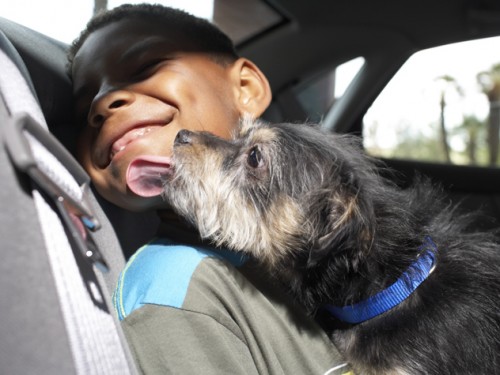
Some repetitive behaviors are made worse because the dog uses them as attention-seeking behaviors. Some dogs find negative attention to be more rewarding than being ignored.
However, before we consider the licking to be attention-seeking behavior, you want to rule out the other reasons first.
Take Your Dog To Work Day: Tips, Tricks and Essential Advice
This year marks the 15th Pet Sitters International’s Take Your Dog To Work Day. The day was created to celebrate canine companionship and boost adoptions. While we all know it’s fun to be able to take your dog to work instead of leaving them behind one day of the year (unless you are lucky enough to work for a company that welcomes pets year round) the day can also cause accidents, especially if you have non-dog savvy workers or a fearful pup.
15 Tips for a Successful Take Your Dog to Work Day
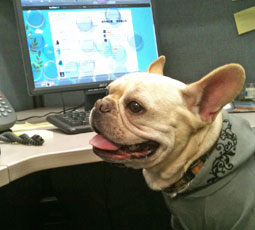
Bathe and groom your dog before her office debut so she is clean and odor-free, and free of any parasites such as fleas or ticks.
Only allow dogs to visit the office who are up-to-date on vaccines, and never bring your dog if he appears sick.
If your dog is aggressive or overly shy, keep him at home. Meeting new dogs and people in an unfamiliar environment can be too stressful for some dogs.
Bring with you everything your dog might need, including food, treats, bowls, toys, and a leash. And don’t forget paper towels, clean-up bags, and pet-safe disinfectant.
To keep your dog comfortable, consider bringing a crate, especially if you are routinely in and out of your office workspace.
Designate an appropriate area where dogs can relieve themselves and stress that people need to pick up after their dogs.
Avoid forcing co-workers to interact with your dog. Those who are interested will seek out you and your dog.
Monitor the amount of treats your pet eats, and educate co-workers ahead of time about what is and isn’t safe for dogs. Bring extra food or treats that your dog is used to that people can safely feed your dog.
Have an exit strategy. It’s OK to take him home at anytime if he is uncomfortable or boisterous and causing a distraction.
Remember that the point of TYDTWD – aside from having fun – is to educate people about pet adoption and helping pets in need.
If your office is closed on Friday or employees are interested in bringing other pets, consider celebrating on another day during Take Your Dog to Work Week, June 16-20, 2014. Or any other time of the year!
Ask your local shelter or rescue group to join your TYDTWD event. They can bring adoptable pets or information about local adoption opportunities and you can hold a fundraiser to benefit the guest shelter.
Take lots of pictures, and share them on your company’s website or social media pages. You could also have a photo contest or award prizes for cutest dog or best owner-dog look-a-likes.

7 Rules Everyone in the Office Should Follow for Take Your Dog to Work Day
Have a great Take Your Dog to Work Day by following these rules! If you have any questions, always ask your co-worker first before say hi to their dog.
Never approach another co-worker’s dog with your dog, it may not be dog-friendly
Always ask your co-worker before you greet the dog
Always approach a dog from the side, do not stare directly at the dog’s face, and do not reach over the dog’s head
Do not approach a dog that a co-worker has left alone in their office
Do not feed a dog without permission (she may have allergies)
Avoid coming up behind a dog, it can startle him
Avoid bending over a dog. Instead, kneel by their side
If you know your dog is shy of people, tie a yellow ribbon on his leash and collar for the day, so the rest of the office will know.
If you see a yellow ribbon on a dog, the best thing to do is ignore him. Even if he comes up and sniffs you. Just because he is checking you out to see if you are a threat, does not mean they want you pet him.

Look for these signs and stop approaching the dog if you see any of them, even if the owner is telling you the dog is friendly. All of these are signs the dog is uncomfortable and may bite if pushed.
Whites of the eyes
Cowered, low body posture
Tail low-set and/or tucked (for breed)
Ears low or back
Piloerection (hair along back and neck raised)
High tail set (for breed) with a slow or very rapid wag
Freezing
Backing away
Hiding behind owner or furniture
Baring of teeth
Growling, barking
Lunging
Use your best judgment and err on the side of caution. If you are unsure, it’s best to just not pet the dog.
At-Home Dental Care for Your Pet
Many pet owners dismiss their pets’ bad breath as simply “normal” or something to be ignored. However, bad breath is a hallmark of periodontal disease, a bacterial infection of the gums and supporting structures of the teeth. If you notice that your pet’s mouth has an odor and/or you observe discolored teeth, he or she may have developed some degree of periodontal disease. What starts as gingivitis (inflammation of the gums) can quickly lead to permanent loss of gum tissue, damage to ligaments and loose or missing teeth. Periodontal disease can cause bacteria from the mouth to enter the pet’s bloodstream and circulate through the heart, liver and kidneys.
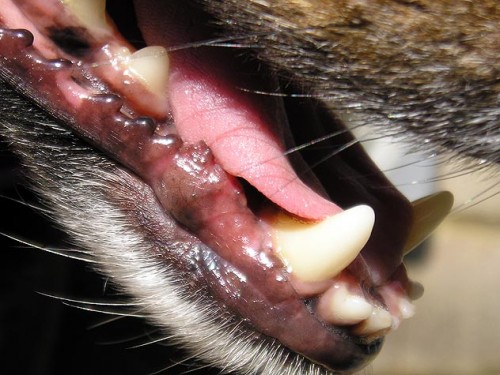
At-home care can include the use of water additives, tooth brushing with specially-formulated toothpaste for pets, dental chew toys, kibble designed to clear and prevent the build-up of plaque and paying special attention to any changes your pet exhibits. As a pet owner, you should examine your pet’s mouth at least once a week to look for signs of swollen or bleeding gums (gingivitis), brown buildup on teeth (plaque/tartar) and abnormal lumps, bumps or swellings. Be sure to examine the back teeth (molars) by lifting the lip to expose the outside surfaces of the teeth. Also, observe the color of your pet’s gums. The gums should be shiny and pink — not white or dark red.
If you notice any usual signs or symptoms or changes in your pet’s mouth, consult your veterinarian to schedule an exam. He or she will examine your pet, inform you of any problem areas and make treatment recommendations. You might need to schedule a professional dental cleaning, according to your veterinarian’s recommendations for your pet’s particular breed and condition.
Tarry or Bloody Stool in Dogs

Everyone loves candy and on Halloween candy is everywhere. While your dog may have never been tempted by sweet treats before, keep in mind that candy probably has never been so accessible! On Halloween candy can be found in bowls, on tables, next to doors, in trick or treat bags being carried at dog level and in the hands of small children who might think your dog would like to share the snack. Candy also makes it onto the floor when spilled during the handout or dumped out for the all-important candy sort.
Spooky Sugar and Frightful Fats
While not all candy is specifically poisonous to dogs, it does contain large amounts of sugar and fat. The ingestion of large amounts of either can lead to pancreatitis in dogs.
Chocolate Nightmares
Present in a substantial amount of Halloween goodies, chocolate is highly poisonous to dogs even in small amounts (learn more about dogs and chocolate) and should never be shared with your pet.
Wrathful Wrappers
While wrappers are of no interest to humans and often end up scattered on tables and floors, they can look like a delightful snack to your four legged friend. While they might be empty and free of candy, wrappers can actually be as dangerous or even more dangerous than the candy itself. Foil and cellophane can cause life-threatening bowel obstructions, which may require surgery.
Repulsive Raisins
While you might be thrilled to see a healthy treat in Halloween goody bags — beware! Some people switch out the usual candy for a healthy snack of trail mix or raisins. While healthy for humans, raisins are highly toxic to dogs and can cause kidney failure.
Human Halloween Costumes
While you might not think your own costume has anything to do with your dog, there are a few things you should keep in mind.
Halloween costumes, especially children’s costumes, often include small parts and unusual materials that may resemble your dog’s toys or chew toys. They might even make unusual and tempting noises. Be careful not to leave the costume unattended and beware of any loose pieces that may become a doggie disaster.
Glow sticks and glow jewelry are a good way to keep your child visable, but could look like a toy/stick to your dog. If your child is carrying a glow stick, remind them that they should not wave it around in front of the dog. Chewing on glow sticks can cause your dog mouth pain, irritation and drooling and ingesting a glow stick can cause intestinal blockage.
Dog Halloween Costumes
While some dogs might like being dressed up, it’s wise to experiment first to see if a pet likes to be in clothing. When choosing your dog’s Halloween costume, remember these tips:
When selecting a Halloween costume for your dog, make sure that it fits well. A costume that is too restrictive or too loose could cause harm to your dog. Take time to acclimate your dog to the costume prior to the big day.
Make sure pet costumes do not limit an animal’s movement, hearing, sight or ability to breathe or bark. Also check the costume for choking hazards.
For dogs that don’t like cosutmes, a Halloween collar, leash or bandana can be just as festive.
Halloween Decorations
Decorations are a regular part of Halloween fun, but some can pose a safety hazard to your dog and your home. Use fake cobwebs sparingly outdoors. These may adversely affect pets and wildlife. As with any holiday decoration, don’t let pets chew or eat items like crepe paper streamers or tinsel – these can discolor your pet’s mouth, cause upset stomach, choking and intestinal blockage.
Pumpkins and Jack-O-Lanterns
While many people feed small amounts of pumpkin to their dogs for health purposes, there is a big difference between cooked and pureed “food-friendly” pumpkin, and decorative, raw pumpkins.
Dogs should never eat the shell of a pumpkin or gourd, but during the fall season, many decorative pumpkins and gourds are coated with materials, such as glue, glitter or shellac that can be toxic to your pet.
Once Halloween is over, ditch the carved pumpkins. They can become dangerous as they may deteriorate and grow mold over time.
Re-think placing candles in Jack-O-Lanterns. Pets can easily knock them over and start a fire. There are many great battery-operated alternatives to light up your pumpkin that last longer and are safer for everyone!
Stress Free Halloween
Although it is tempting to include your dog in the festivities, sometimes the best option for everyone is to keep the dog away from the festivities all together. Halloween can be a scary and stressful time for your dog. Halloween is synonymous with spooky music, strange noises, creepy decorations and holiday pranks. The yells and screams of trick-or-treaters, doorbells ringing and a parade of costumed strangers at the door might all be in good fun, but your dog probably doesn’t know that.
Keep your dog inside. The late night commotion might cause your dog to spook and flee.
Take your dog on a long walk before Halloween night. This will help with anxiety and get them ready for an early bed time.
Create a quiet and comfortable room for your dog that will not have people going in and out of it. Consider playing music to drown out strange noises.
If you aren’t going to be home for trick-or-treaters, turn off the lights in the house so people will be less likely to knock.
Pumpkin Paw Prints Recipe
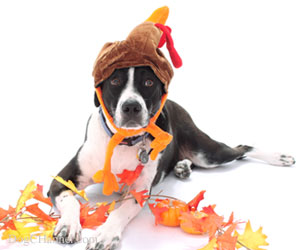
The recipe comes from Roberta Deen of Capers Catering Company in Los Angeles. She is one of the chefs who contributed to the book The Culinary Canine: Great Chefs Cook for Their Dogs- And So Can You!
Easy to make our dogs gobbled them up. They would also make great dog lover gifts to take to your friends this holiday season or any time of year. Package them up in cellophane or a nice tin and you’ll have your friends barking for the recipe.
Ingredients:
1 cup plain pumpkin puree (fresh or canned)
1 cup peeled, 1/4” diced, lightly blanched fresh pumpkin
1/2 cup roasted pumpkin seeds, coarsely chopped
1 cup quick-cooking oats
2 cups whole-wheat flour
1 cup all-purpose flour
1/2 teaspoon cinnamon
1/2 cup molasses
1/2 cup honey
1/2 cup unsweetened applesauce
1/2 cup canola oil
Directions:
Preheat oven to 325 (300 if using a convection oven)*
Mix above ingredients in a large bowl
Add water to achieve a chocolate-chip cookie like consistency
Line baking sheets with parchment paper
Drop by teaspoons (for the petite puppies) and Tablespoons (for the big guys) onto baking sheets about 2 inches apart
Flatten into rounds with a fork in a cross-hatch pattern
Bake for 10 minutes
Switch the baking sheets front to back, top to bottom and bake for 5-10 minutes longer until golden and firm – adjusting time for teaspoons (a bit less) and for tablespoons (a bit longer)
Turn off oven and leave the door open until the treats cool completely
Yield depends upon size of the cookie
Treats should be fed in moderation. Consult your veterinarian any time you are making changes to your dogs food or diet.





